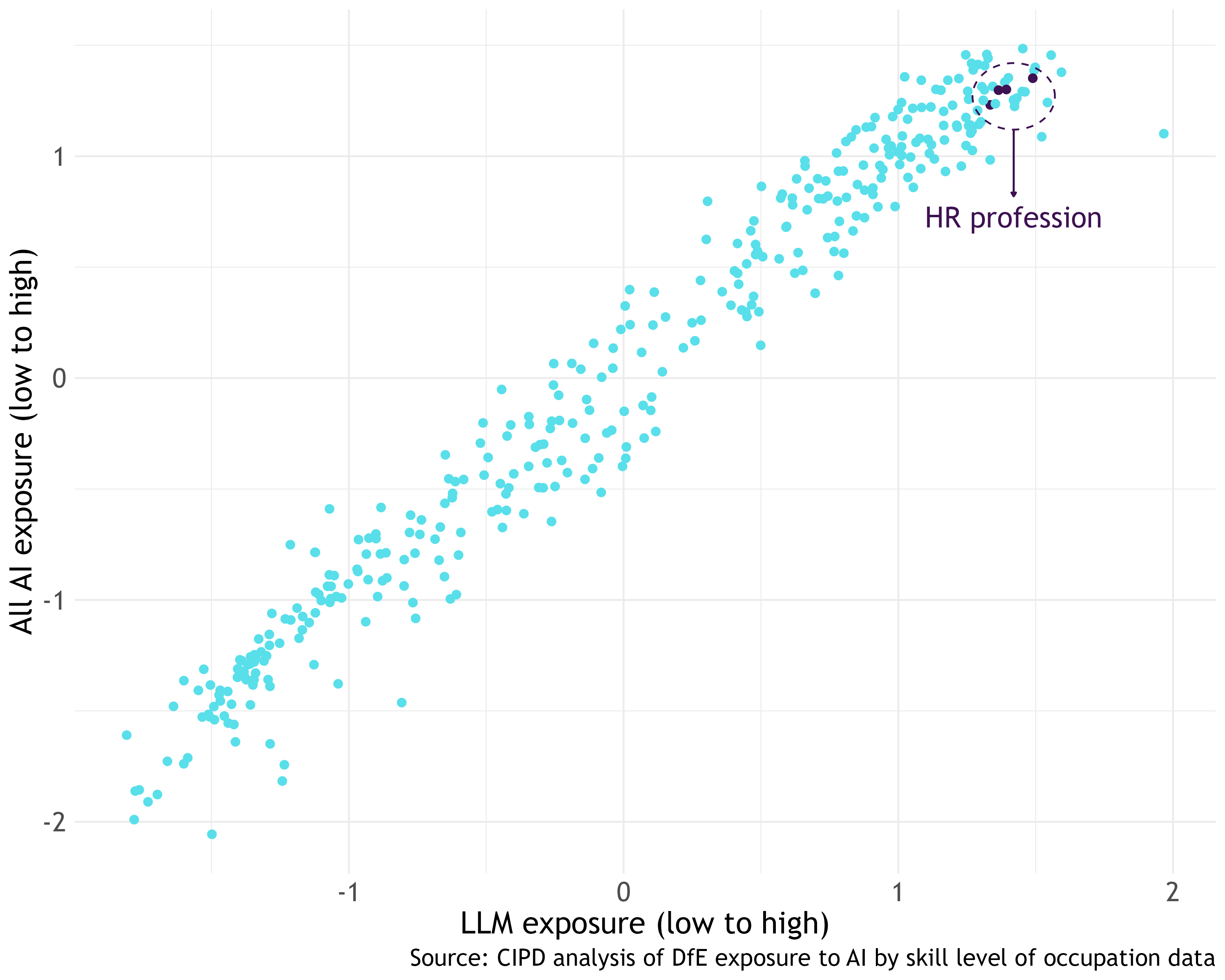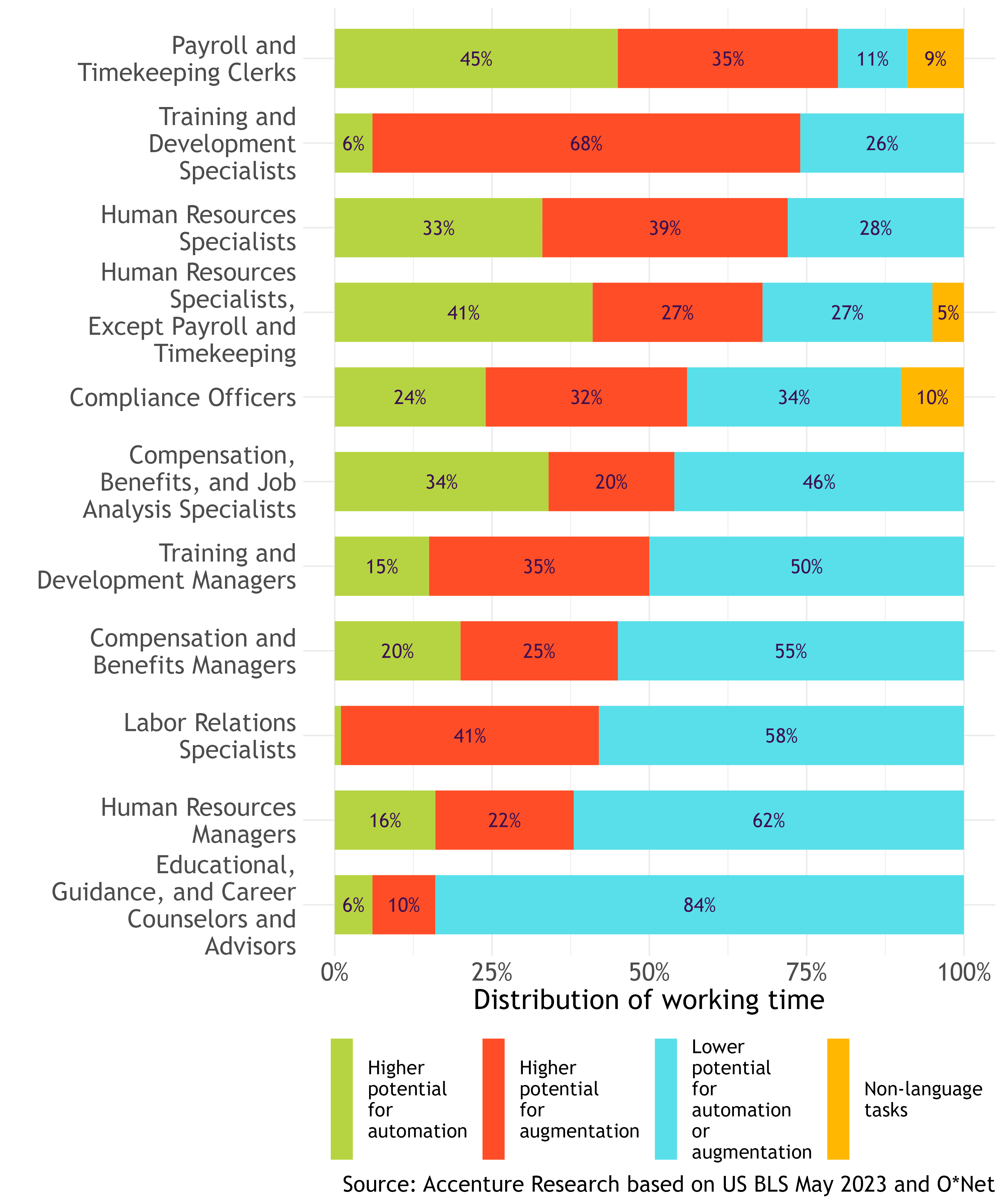
HR People Pod
Listen to episodes of HR People Pod, the CIPD’s fortnightly podcast providing expert insights from HR leaders discussing the topical issues impacting the world of work.
Listen nowWe examine and outline recent research investigating the impact of generative AI tools on the HR profession
In 2013, Frey and Osborne predicted that 47% of jobs in the US could be automated within a decade or two. Their methodology became the blueprint for a raft of copycat studies that sought to refine and update the research. Notable further studies were done by the OECD (2016), who looked directly at the automatability of tasks instead of whole occupations. This was further developed by the UK Office for National Statistics (ONS) (2019). These studies resulted in much lower estimates: the OECD suggested 10% of jobs in the UK would be automated while the ONS put the figure at 7.4%.
The meteoric rise of generative AI after the release of ChatGPT in November 2022 has led to further interest and more attempts to quantify the effects of this technology on jobs. Since Frey and Osborne published in 2013, many of their cited bottlenecks to automation have been overcome. They mentioned the Turing test (a computer’s ability to fool someone into believing it is human) as evidence of social intelligence being a bottleneck to automation. With the advent of generative AI, this threshold was passed without much fanfare. Other bottlenecks included creative tasks such as “poems, musical compositions, scientific theories, cooking recipes and jokes”, which again, could be done with ease using generative AI.
The UK Department for Education sought to show the occupations, sectors and areas within the UK labour market that are expected to be most impacted by AI. In particular, the impact of generative AI tools that use large language models (LLMs).
The 2023 report made clear that the estimates showed the relative exposure of UK jobs to AI as opposed to the absolute impact of AI. It did not distinguish whether a job would be augmented (aided) or substituted (in other words, replaced or automated) by AI. The relative exposure is presented as an 'AI occupational exposure' score.
HR administrative occupations are in the top 20 occupations with the greatest exposure to all AI applications. These are joined by HR managers and directors, as well as vocational and industrial trainers, in the top 20 list for exposure to LLMs.
This is most evident in Figure 1 where all ‘HR’ occupations are in the top right of exposure among both measures of AI occupational exposure.
Figure 1: HR roles are highly exposed to all types of AI including LLMs

These occupational exposure scores for each job role are based on the abilities required to perform them. Each of these abilities themselves have their own AI occupational exposure index. The Occupational Information Network (O*NET) also ranks the importance of each of these abilities within each job.
Putting the two together, we see two clusters which lead to the high AI occupational exposure index for HR managers, for example (Figure 2). These are high importance, medium exposed abilities and medium importance, highly exposed abilities as defined in Table 1.
Figure 2: HR managers ranked importance of abilities and their exposure to AI

Table 1: Importance and exposure to AI of selected abilities required among HR managers
| High importance and medium exposure | Medium importance and high exposure |
| Oral expression | Information ordering |
| Oral comprehension | Memorisation |
| Written expression | Speed of closure |
| Written comprehension | Flexibility of closure |
| Speech recognition | Category flexibility |
| Speech clarity | |
| Deductive reasoning | |
| Problem sensitivity | |
| Inductive reasoning |
These abilities can be abstract concepts to grasp. Another paper used more specific tasks as examples.
The World Economic Forum (WEF), in partnership with Accenture, adopted a task-based approach to assess the exposure of each occupation to LLMs. The paper analysed 19,265 tasks available in the O*NET database, assessing the potential exposure of each task to LLM adoption. They classified the tasks as:
The resulting chart (Figure 3) shows the impact of LLMs on the HR function, with roles most likely to be affected by automation and augmentation at the top, and those least likely to be affected at the bottom. As with many other professional roles, there is considerable likelihood of both automation and augmentation.
The research found that tasks with the highest potential for automation by LLMs tend to be routine and repetitive – 41% of the time spent by HR assistants and 45% of the time spent by payroll and timekeeping clerks is spent on these tasks. Those working as training and development specialists have the highest potential for augmentation (68%) in their roles as it requires abstract reasoning and problem-solving skills. Tasks with lower potential for exposure require a high degree of personal interaction and collaboration, this takes over half (62%) of the time spent by an HR manager, for example.
Figure 3: Automation and augmentation impact of LLMs on the HR function

Overall, the existing evidence suggests roles within the HR function are susceptible to both automation (substitution) and augmentation to varying degrees due to generative AI. But compared to many other professional roles, the HR function is more likely to be impacted, due to the rise of generative AI tools that use LLMs (such as ChatGPT).
There will be further research into the impact of AI in the months and years to come as it becomes embedded in our daily lives. The CIPD will also continue to investigate the subject of AI and the implications for the people profession, and publish further content in the near future.


Listen to episodes of HR People Pod, the CIPD’s fortnightly podcast providing expert insights from HR leaders discussing the topical issues impacting the world of work.
Listen now
James Cockett, Senior Labour Market Economist, explores how UK organisations are adopting generative AI, where they are on their AI maturity journey, and how productivity pressures are shaping both uptake and concerns.

Hayfa Mohdzaini, Senior Policy and Practice Advisor for technology, explores why AI governance is a natural extension of HR’s existing responsibilities and how people professionals can help ensure AI is used responsibly across organisations.

Leading Voices is a series of short audio essays in which senior people professionals reflect on how they have tackled some of the profession's most pressing challenges.

Find out what people professionals said about their working lives and career development prospects in our recent pulse survey

As artificial intelligence continues its rapid advancement and becomes the much touted focus for investment and development, we highlight the critical role of the people profession and explain how the CIPD and its members will be involved shaping its impact at work

A look at whether artificial intelligence can cover skills shortages by exploring the benefits of AI and the advantages that can be gained by using generative AI such as ChatGPT

Jon Boys discusses the benefits of generative AI tools, and how organisations can utilise them